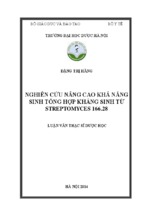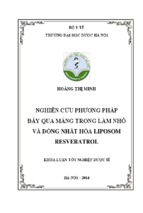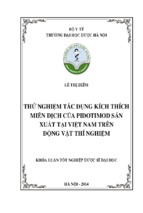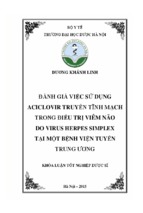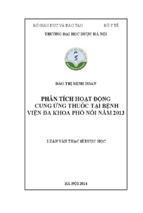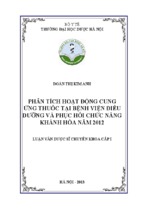From the Division of International Health (IHCAR)
Department of Public Health Sciences
Karolinska Institutet, Stockholm, Sweden
Sexually Transmitted Infections
and other Reproductive Tract Infections
in Rural Vietnam
Current situation, management and implications for control
Phạm Thị Lan
Stockholm 2009
Published by Karolinska Institutet. Printed by Universitetsservice US – AB
Box 200, SE-171 77 Stockholm, Sweden
© Pham Thi Lan, 2009
ISBN 978-91-7409-366-7
ABSTRACT
Background: Sexually transmitted infections (STI) and other reproductive tract infections (RTI)
constitute a huge health and economic burden in low-income countries. The infections may result in
severe sequelae, particularly in women, and facilitate HIV acquisition and transmission. In Vietnam,
women from rural or remote areas delay before seeking care for STI. Little is known about the
situation regarding STI/RTI in the community.
Aims: To explore perceptions and attitudes towards STI/RTI among people in the community; to
assess the knowledge of STI and possible associations between socioeconomic determinants and STI
knowledge among women aged 15 to 49; to investigate the prevalence of STI/RTI and related factors
among married women aged 18 to 49; and to assess healthcare providers’ (HCPs’) knowledge and
reported practices regarding STI.
Methods: Ten focus group discussions (FGDs) were conducted with a total of 73 participants aged
15 to 49 (46 women and 27 men) in Bavi district (Study I). Face-to-face interviews using a structured
questionnaire about STI knowledge were carried out among 1805 women aged 15 to 49 randomly
selected from 17 clusters of an epidemiological field laboratory in Bavi district (FilaBavi) (Studies II,
III). In total, 1,012 married women, in addition to being interviewed, underwent a gynaecological
examination. Specimens were collected for laboratory diagnostics of chlamydia, gonorrhoea,
trichomonas, bacterial vaginosis (BV), candidiasis, hepatitis B, HIV, and syphilis (Study III). HCPs
working in Bavi district, including 390 medical personnel and 75 pharmacy personnel participated in
a self-completion questionnaire survey on STI knowledge and case scenarios (Study IV).
Results: In the FGDs, RTI, gonorrhoea and syphilis was described as three stages of an STI. Healthseeking patterns for STI/RTI were reported to differ between men and women: self-medication was a
common practice among women, while men were more likely to seek healthcare from private HCPs.
Complaints were voiced about clinicians’ negative attitudes towards STI/RTI patients (Paper I).
Among 1,805 women, 78% did not know of any symptom of any STI. Of 40 possible correct
answers, the mean knowledge score was 6.5. Young and/or unmarried women demonstrated very low
levels of STI knowledge. Experience of an induced abortion predicted a higher level of knowledge
(Paper II). Of the 1,012 married women, 39% were aetiologically confirmed as having an STI/RTI.
Endogenous infections were most prevalent (candidiasis 26%, BV 11%) followed by hepatitis B
8.3%, Chlamydia trachomatis 4.3%, Trichomonas vaginalis 1%, Neisseria gonorrhoeae 0.7%,
genital warts 0.2%, HIV and syphilis 0%. Prevalence of any STI was 6.0%. Age under 30 years or
using an intrauterine device were significantly associated with increased risk of BV. Determinants of
candidiasis were vaginal douching, high education level and low economic status, whereas a
determinant of chlamydia was high economic status. Out migration of the husband was associated
with an increased risk of hepatitis B surface antigen seroposivity among women. Compared with the
laboratory diagnostics, both self-reported symptoms and clinical diagnosis had very low sensitivity
and positive predictive values (Paper III). Of 465 HCPs, 70% acknowledged the necessity for partner
treatment for BV or candidiasis cases (which is often not the case). Sharing clothes/food or kissing
were commonly mentioned as transmission routes of STI (60%). Mean score of knowledge and
reported practice were 28.2 (minimum 0, maximum 50, median 26) and 4.7 (minimum 0, maximum
20, median 2), respectively. Of the HCPs, 34% and 78% had suboptimal knowledge and practice
score (below 50% of the total score). Being a medical doctor, assistant medical doctor, midwife or
serving STI patients predicted a higher level of knowledge. Additionally, serving STI patients, being
a midwife, female provider, and having participated in STI/RTI training courses predicted higher
level of practice (Paper IV).
Recommendations: Health education interventions to improve knowledge of STI/RTI for
community members as well as HCPs are urgently needed. Further, communication between
STI/RTI patients and clinicians needs to be improved. Syndromic algorithms should be supplemented
by risk assessment in order to reduce under and over treatment. Microscopic diagnosis could be
applied in primary care settings to achieve more accurate diagnoses. Vaccination to prevent hepatitis
B for migrants should be considered.
Keywords: sexually transmitted infections; reproductive tract infections; prevalence; knowledge;
perception; attitude; health-seeking pattern; community; healthcare provider; rural; Vietnam
3
LIST OF PUBLICATIONS
This thesis is based on the following papers, which will be referred to by their Roman
Numerals I-IV.
I.
Lan PT, Faxelid E, Chuc NTK, Mogren I, Stålsby Lundborg C. Perceptions and
attitudes in relation to reproductive tract infections including sexually
transmitted infections in rural Vietnam: A qualitative study. Health Policy
2008;86:308-17.
II.
Lan PT, Stålsby Lundborg C, Mogren I, Phuc HD, Chuc NTK. Lack of
knowledge about sexually transmitted infections among women in rural
Vietnam. (Submitted for publication).
III.
Lan PT, Stålsby Lundborg C, Phuc HD, Sihavong A, Unemo M, Chuc NTK,
Khang TH, Mogren I. Reproductive tract infections including sexually
transmitted infections: a population-based study of women of reproductive age
in a rural district of Vietnam. Sex Transm Infect 2008;84(2):126-32.
IV.
Lan PT, Mogren I, Phuc HD, Stålsby Lundborg C. Knowledge and practice of
healthcare providers regarding sexually transmitted infections in rural Vietnam.
Sex Transm Dis. (In press).
All papers were reproduced with permission from the copyright holders.
4
ABBREVIATIONS
AIDS
AMD
ANC
BV
CI
CHC
DHC
ELISA
FGD
FSW
GDP
GSO
HBsAg
HIV
HMU
HSRP
ICC
IEC
IDU
IUD
IHCAR
MD
MOH
MSM
NIDV
NPV
OR
PCR
PLWHA
PPV
RPR
RTI
SD
Sida
STI
UNAIDS
UNFPA
WHO
Acquired Immunodeficiency Syndrome
Assistant Medical Doctor
Antenatal Care
Bacterial Vaginosis
Confidence Interval
Commune Health Centre
District Health Centre
Enzyme-linked immunosorbent assays
Focus Group Discussion
Female Sex Worker
Gross Domestic Product
General Staticstical Office
Hepatitis B surface antigen
Human Immunodeficiency Virus
Hanoi Medical University
Health System Research Project
Intra Cluster Correlation
Information, Education and Communication
Intravenous Drug User
Intrauterine Device
Division of International Health, Karolinska Institutet
Medical Doctor
Ministry of Health
Men who have Sex with Men
National Institute of Dermato-Venereology
Negative Predictive Value
Odds Ratio
Polymerase Chain Reaction
People living with HIV/AIDS
Positive Predictive Value
Rapid Plasma Reagin
Reproductive Tract Infections
Standard Deviation
Swedish International Development Cooperation Agency
Sexually Transmitted Infections
United Nations Joint Programme on AIDS
United Nations Population Fund
World Health Organization
5
PREFACE
I graduated from Hanoi Medical University (HMU), Vietnam in 1990, then continued
with a three year postgraduate training as a resident doctor in dermato-venereology and
obtained a Master of Science in Medicine in 1998. Since 1995, I have been working as a
lecturer at HMU and as a dermato-venereologist at the National Institute of DermatoVenereology (NIDV), Hanoi, Vietnam.
In Vietnam, the economic reform happened in 1986, during my studies at the medical
university. I, have therefore experienced at first hand the changes from the “closed door”
to the “open door” policies. The open door policy - “Renovation” has marked a new step
forward for the economy and society. This has had a great impact on urbanization,
migration and the lifestyles of people. Together with other changes in economic and
social life, sexuality is gradually becoming far more open than it was in the past.
Moreover, since the first case of HIV appeared in Vietnam in 1990, there has been a
rapid increase in numbers despite the great efforts of the government to combat it.
Working at the NIDV as a clinician, I have seen many STI patients from a variety of
areas and socio-economic backgrounds with different kinds of infections that have been
transmitted sexually and have learnt a great deal about the different risks in this field.
The common factors are that they have engaged in unprotected sexual intercourse with
high risk groups or got the infections from their spouses/partners. It seems that the STI
patients are afraid of being infected by HIV, but are far less worried about other STI. I
have well understood that STI patients either belong to high risk groups or act as bridges
to potentially transfer the infections most often from high risk groups to the general
population. However knowledge about STI/HIV among the general population is very
limited, especially among rural dwellers who make up the majority of population of
Vietnam.
I have been involved in the Health System Research Project, Vietnam since 2003. I saw
my field work at FilaBavi as providing a good opportunity to visit households and health
centres, and to talk with people in the community and health staff in order to gain a
preliminary understanding about the issues that interested me. I was told that
“gynaecological disease” was very common among local women in Bavi district, and
that out of ten women, eight to nine would have “gynaecological disease”, further
“veneral disease” or STI were also common. I was curious as to whether the infections
were so common. If they were, why? and if they were, something had to be done for this
community to reduce the morbidity.
The above reasons made me become very interested in an investigation of STI/RTI with
the emphasis on the STI situation from different perspectives with the hope that
contributions from the studies in this thesis would be of use for combatting
STI/RTI/HIV in my country.
In 2004, I was registered as a PhD student at IHCAR, Karolinska Institutet. The training
that I have gone through during these years has further provided me with broader views
on those factors that impact on the morbidity of the population as a whole. This has also
enhanced my clinical view on each individual case.
6
CONTENTS
ABSTRACT .........................................................................................................3
LIST OF PUBLICATIONS.................................................................................4
ABBREVIATIONS .............................................................................................5
PREFACE ............................................................................................................6
1
BACKGROUND ..........................................................................................8
1.1 STI/RTI – a public health problem.....................................................8
1.2 STI/RTI prevention and control .........................................................9
1.3 Vietnam .............................................................................................12
1.4 Rationale of the studies.....................................................................21
2
AIMS AND OBJECTIVES........................................................................23
2.1 Aims ..................................................................................................23
2.2 Objectives..........................................................................................23
3
METHODS .................................................................................................24
3.1 Study design ......................................................................................24
3.2 Study setting......................................................................................25
3.3 Sample size and sampling.................................................................27
3.4 Data collection ..................................................................................29
3.5 Data analysis .....................................................................................34
3.6 Ethical considerations .......................................................................35
4
MAIN RESULTS .......................................................................................36
4.1 Community’s perceptions about STI/RTI (I)...................................36
4.2 Attitudes towards STI/RTI and health-seeking patterns (I).............38
4.3 Knowledge of STI and predictive factors (II, IV)............................40
4.3 Healthcare providers’ reported practice (IV) ...................................44
4.4 Prevalence of STI/RTI (III) ..............................................................46
5
DISCUSSION.............................................................................................49
5.1 STI/RTI prevalence and diagnostics ................................................49
5.2 STI/RTI and determinants ................................................................51
5.3 Community and HCPs’ perceptions regarding STI/RTI .................53
5.4 Lack of STI knowledge among community members and HCPs ...54
5.5 Low levels of practice among HCPs ................................................56
5.6 Stigma, gender and health-seeking behaviours................................57
5.7 Methodological reflections ...............................................................59
6
CONCLUSIONS ........................................................................................64
7
RECOMMENDATIONS ...........................................................................65
8
ACKNOWLEDGEMENTS .......................................................................66
9
REFERENCES ...........................................................................................69
10 APPENDICES ............................................................................................81
PAPERS I-IV
7
1 BACKGROUND
Reproductive tract infections (RTI) refer to three types of infections, which affect the
reproductive tract: i) sexually transmitted infections (STI) transmitted through sexual
activity with an infected partner; ii) endogenous infections resulting from an overgrowth
of organisms normally present in the vagina, including bacterial vaginosis and
candidiasis; and iii) iatrogenic infections occurring when micro-organisms are
introduced into the reproductive tract by unsterilized surgical instruments through a
medical procedure such as menstrual regulation, induced abortion, insertion of an
intrauterine device (IUD) or termination of a pregnancy.126, 180
In most cases, STI have more severe health consequences than other RTI, the term
STI/RTI is used throughout the thesis to highlight the importance of STI within
reproductive tract infections. When information provided is relevant to sexually
transmitted infections only, the term STI has been used alone.
1.1
STI/RTI – A PUBLIC HEALTH PROBLEM
The global disease burden of STI/RTI is well documented as a major public health
concern.144 In low-income countries, STI are the second cause of healthy life lost in
women, after maternal morbidity and mortality.144 Among women, non-sexuallytransmitted RTI are usually even more common.180 STI/RTI may result in severe
sequelae, particularly in women, such as pelvic inflammatory diseases, infertility,
ectopic pregnancy, cervical cancer, maternal infections, perinatal deaths, and potentially
blinding eye infections in infants.35, 45, 126, 181 Unfortunately, symptoms and signs of
many infections may not appear until it is too late to avoid the consequences and
damage of the reproductive organs. Furthermore, STI/RTI are important cofactors of the
acquisition and transmission of human immunodeficiency virus (HIV).27, 45, 138
Ulcerative STI increase the risk of HIV acquisition through sexual intercourse most
dramatically because genital ulcers and lesions allow easier entry of infectious particles.
Inflammatory STI/RTI increase genital shedding of HIV infected cells. In addition,
urethral and endocervical infections that cause inflammation allow for more efficient
exchange of infectious particles, making transmission more likely.126
STI are caused by about 30 different identified agents, of which bacteria, protozoa, and
parasites can be killed by effective medications. In spite of the availability of effective
treatment, bacterial STI are still a major public health concern in all countries
irrespective of economic level. The main STI (excluding HIV) that are important from a
public health perspective are syphilis, gonorrhoea, chlamydia and trichomonasis.180 The
World Health Organization (WHO) estimates that apart from AIDS, there are over 340
million new cases of curable STI each year worldwide in men and women aged 15–49
years, including trichomonasis, chlamydial infection, gonorrhea and syphilis.178
Millions of viral STI cases also occur annually, attributable mainly to HIV, human
herpes viruses, human papilloma viruses and hepatitis B virus.80, 178
8
Globally, STI/RTI constitute a huge health and economic burden, especially for lowincome countries where they account for 17% of economic losses caused by illhealth.80 The morbidity associated with STI/RTI also affects the economic productivity
and quality of life of individuals as well as whole communities. The socioeconomic
costs of these infections and their complications are substantial,35 ranking among the
top ten reasons for healthcare visits in most low-income countries, despite that many
STI patients do not seek healthcare from health facilities, and substantially drain both
national health budgets and household income.178 The social costs include conflict
between sexual partners and domestic violence. The costs increase further when the
cofactor effect of other STI on HIV transmission is taken into consideration.178
1.2
STI/RTI PREVENTION AND CONTROL
The necessity for prevention and control
To reduce morbidity and mortality
To limit the morbidity and mortality associated with both STI and HIV, prevention is
crucial.126 Primary strategies for preventing the transmission of STI are the same as
those for HIV/AIDS.126 Infections with sexually transmitted pathogens other than HIV
impose a huge burden of morbidity and mortality in all countries irrespective of income
level. The infections may impact directly on quality of life, reproductive health and child
health, and indirectly on facilitating HIV transmission, and on national and individual
economies.35, 178 The health consequences of STI range from mild acute illness to
painful disfiguring lesions and psychological morbidity. In addition, there is a large
economic burden and loss of productivity to individuals and nations as a whole.178 Thus,
the infections should be controlled in their own right as a public health problem.
To prevent HIV infection
While HIV/AIDS can only be suppressed using antiretroviral (ARV) therapy, the
majority of STI/RTI can be cured by medication. Consequently, improved case
management of STI is one of the interventions scientifically proven to reduce the
incidence of HIV infection in the general population.45, 76 Preventing and treating STI
reduces the risk of sexual transmission of HIV,126 especially among populations who
have a high number of sex partners, such as sex workers and their clients. The
presence of an untreated inflammatory or ulcerative STI increases the risk of
transmission of HIV during unprotected sex.126, 177 Genital ulcers have been estimated
to increase the risk of transmission of HIV 50–300-fold per episode of unprotected
sexual intercourse.178 Services providing care for STI are one of the key entry points
for HIV prevention. Patients seeking care for STI are a key target population for
prevention, counselling and voluntary and confidential testing for HIV, and may be in
need of care for HIV/AIDS because they may have primary HIV infection at the same
time. Effective prevention messages, treatment for STI, and promotion of condoms
could have a substantial impact on HIV transmission.178
9
To prevent serious complications and adverse pregnancy outcomes
STI are the main preventable cause of infertility, particularly in women. Between 10%
and 40% of women with untreated chlamydial infection develop symptomatic pelvic
inflammatory disease (PID).149 Post-infection tubal damage is responsible for 30% to
40% of cases of female infertility. Furthermore, women who have had PID are 6 to 10
times more likely to develop an ectopic pregnancy than those who have not, and up to
50% of ectopic pregnancies can be attributed to previous PID.178 Prevention of PID
will prevent the majority of mortality related to ectopic pregnancy. Prevention of
human papilloma virus infection will reduce the number of women who die from
cervical cancer,126, 178 the second most common cancer in women after breast
cancer.178
Untreated STI are associated with congenital and perinatal infections in neonates. In
pregnant women with untreated early syphilis, 25% of pregnancies result in stillbirth
and 14% in neonatal death.178 Untreated gonococcal infection in pregnant women may
result in spontaneous abortions, premature births, and up to 10% in perinatal deaths.
Infants born to mothers with untreated gonorrhoea and/or chlamydial infection will
develop ophthalmia, which can lead to blindness of about 4,000 newborn babies
worldwide annually.178 Furthermore, BV may lead to premature birth, low birth
weight; or even infertility or ectopic pregnancy.77, 126 In short, high rates of
preventable reproductive morbidity and mortality related to STI/RTI make prevention
and control of these infections a public health priority.180
The approach for prevention and control
To reduce the burden of STI/RTI, efforts are needed among both healthcare personnel
and the community. Effective prevention and management practised by healthcare
providers (HCPs) reduce the STI/RTI burden in several ways. Effective treatment
reduces STI prevalence, and thereby decreases transmission in the community. HCPs
play a critical role in controlling the spread of STI through early and accurate diagnosis,
appropriate treatment, and counselling regarding prevention.63, 183 Moreover, safe and
appropriate clinical procedures mean fewer iatrogenic infections. Community education
is needed to promote prevention of infection and use of healthcare services and
therefore, reduce disease transmission within the community.180
Syndromic management of STI/RTI
Timely diagnosis and effective treatment for STI have always been important in limiting
the morbidity and mortality associated with these infections. There have been two main
approaches to diagnosis of STI/RTI: clinical and laboratory. Clinical diagnosis relies on
recognition of symptoms by the patient and identification of signs from the clinician’s
medical experience. It is an inexpensive approach and treatment can begin immediately.
However, it is unstandardized and often unreliable.126, 179, 181 Laboratory diagnosis is a
more accurate way to identify STI/RTI, however it often requires resources (e.g.
equipment, trained technicians), it may require patients to make several visits to the
clinic, and almost always results in delayed treatment.126, 180, 181 Effective management
10
of STI is one of the bases of STI control, because it prevents the development of
complications and sequelae, decreases the spread of the infections in the community and
it also offers a unique opportunity for targeted education about HIV prevention.179
Therefore, in order to standardize and improve clinical practice, the WHO has
developed the so-called syndromic management approach.
The syndromic management approach is based on the identification of syndromes,
which are combinations of symptoms and signs, and the provision of treatments, which
are effective for organisms most commonly responsible for each syndrome.126, 179, 180
Using the syndromic approach to STI case management is a practical way to diagnose
and treat STI/RTI cases while helping to prevent further spread of STI. It allows health
workers to diagnose and treat patients during the patient’s first visit without the need to
return to the clinic, and without waiting for the results of laboratory tests.181
WHO has developed simple flowcharts to guide HCPs in using the syndromic
approach to managing STI syndromes, of which four syndromes are covered in the
training package, including (i) urethral discharge in men, (ii) vaginal discharge, (iii)
lower abdominal pain in women, and (iv) genital ulcer in men and women.181
Management is simplified by the use of clinical flowcharts and standardized
prescriptions. Primary HCPs can be trained to use the syndromic approach.126
Comprehensive syndromic management for STI includes correct drug treatment,
condom promotion and provision, identification and treatment of sexual partners, and
counseling to promote risk reduction.
Despite the limitation in finding asymptomatic cases,126 and the criticisms regarding
the waste of a lot of drugs and promoting the development of antibiotic resistance,181
the syndromic approach has proved to be cost-effective and particularly suitable for
resource-poor settings where diagnostic facilities are either lacking or unreliable.80
Furthermore, syndromic management guidelines are widely used for syndromes such
as lower abdominal pain, urethral discharge and genital ulcer, even in high-income
countries with advanced laboratory facilities.180
Challenges for STI/RTI control in low-income countries
Epidemiological patterns of STI vary geographically and are influenced by cultural,
political, economical and social powers. Many people affected by STI are in
marginalised vulnerable groups. The asymptomatic nature of some STI remains a
challenge to HCPs in areas of the world where laboratory screening tests are
unaffordable.71 Many people with STI/RTI do not seek treatment because they are
asymptomatic or have mild symptoms (Figure 1). Others who have symptoms may
prefer self-treatment or seek treatment at pharmacies or traditional healers. Even those
who come to a clinic may not be properly diagnosed and treated. Consequently, only a
small proportion of people with an STI/RTI may be cured and reinfection avoided.180
11
Figure 1. Barriers to STI/RTI control—finding people with an STI/RTI
People with STI/RTI
Symptomatic
Seek care
Accurate diagnosis
Correct treatment
Completed treatment
Cured
Asymptomatic
Do not seek care
Inaccurate diagnosis
Incorrect treatment
Incompleted treatment
Not cured
Source: Adapted from WHO 2005180
Beside a number of challenges to providing effective STI/RTI services to people who
need them, syndromic management of vaginal discharge has proven problematic for
the detection and management of cervical infections, particularly in areas of low
prevalence of STI. Hence, affordable, rapid diagnostic tests are needed. Such tests
have been slow to be developed and, where available, they are still too expensive for
governments to incorporate into national care programmes.178
Common reasons why STI control programmes often fail in low-income countries 80
•
•
•
•
•
1.3
Low priority for policy makers and planners in allocating resources
because STI are perceived as a result of shameful behaviour.
Failure to recognise the magnitude of the problem in the population.
Failure to associate the diseases with serious complications and sequelae.
Control efforts concentrated on symptomatic patients (usually men) and
failing to identify asymptomatic individuals (commonly women) until
complications develop.
Little emphasis on educational and other efforts to prevent infection
occurring in the first place, especially among adolescents.
VIETNAM
General information
Geographic and demographic information
Vietnam is situated in Southeast Asia with an area of about 330,000 km2, three-quarters
of which are mountainous and hilly areas. The Red River delta in the North and the
Mekong delta in the South are the two largest low flat deltas upon which 40% of the
12
Vietnamese population lives. There are more than 54 ethnic groups of which the Kinh is
the majority (86%), followed by four other groups that have populations of more than
one million: Tay, Thai, Muong and Kh’mer (National Census 1999). Vietnamese is the
official language. Vietnam has a population of approximately 84 million, and is the
world’s 14th most densely populated country. The country's two largest population
centres are Hanoi and Ho Chi Minh city, but more than 75% of the population live in
rural areas.
In 1986, the Vietnamese Government initiated a new economic policy known as “Doi
Moi” or “Renovation”. The new policy firmly put Vietnam on the path to transforming
itself from a subsidized socialist economy to a market-oriented economy. As a result,
Vietnam has seen dramatic social and economic changes. In general, people’s livelihood
in urban as well as rural areas has been improved. Vietnam's health indices have greatly
improved, and are much better than one would expect considering the level of economic
development. However health inequalities are now growing between different groups
and geographical areas because of increasing economical gaps. Maternal and child
mortality are much higher among the poor and among some ethnic groups. Infant
mortality in remote areas is nearly eight times greater than in urban areas. Malnutrition
is still a serious problem among poor children. More than 10,000 people die from road
accidents every year, the HIV/AIDS epidemic is escalating becoming one of the 10
leading causes of mortality in the country.88, 90 The number of non-communicable
diseases, such as cancer, diabetes and heart disease, has risen in recent years, accounting
for nearly half of all deaths. Meanwhile, some communicable diseases, such as
tuberculosis continue to persist. Some basic data and health indicators are shown in
Table 1.
Table 1. Basic data about Vietnam
Indicators
Values
Area (km2)
Population (million)
Female (million)
Population density (person/km2)
Life expectancy (year)
Population growth rate (%)
Infant mortality rate per 1,000 live births
Under-5-year mortality rate per 1,000 live births
Maternal mortality ratio per 100,000 live births
Low birth weight (< 2500 g, %)
Under-5-year malnutrition rate (%)
HIV/AIDS adult prevalence rate (%)
GDP per capita (USD)
Number of MD* per 10,000 inhabitants
Number of MD and AMD* per 10,000 inhabitants
Number of nurses* per 10,000 inhabitants
Number of university pharmacists* per 10,000 inhabitants
329,314
84.2
42.8
254
72.0
1.33
16
26
75.1
5.3
23.4
0.5
720
6.23
12
6.77
1.27
Source: MOH, Vietnam, 2006.90 MD: Medical doctor; AMD: Assistant medical doctor
* Excluding personnel of private sectors because of lack of information
13
Educational status
In general, literacy of people aged 10 years and over is 93%.90 It is much higher among
people belonging to the highest economic category than that of people in the lowest
economic category (98% vs. 85%).90 The average years of schooling is about 8.6. There
is no major difference in educational attainment between male and female youth.
However, there is a wide difference in enrollment rates between rich and poor, and
urban and rural at secondary and high school education. The introduction of a market
economy together with the removal of the subsidy system lead to 30% of students
dropping out of school after finishing 5th grade, and cumulatively by the end of
secondary school 75% of students have dropped out.90 The concept of “respecting men
and despising women” (trọng nam, khinh nữ) is still deep-rooted in rural areas. It is
considered that only men need to learn, while higher education for women brings no
benefit because female labour is mostly concentrated in agricultural production.21
Consequently, rural girls tend to discontinue their education earlier to assist their family
by working.139 They usually find a job and earn an income or get married.21
Family planning
In Vietnam, policies on population and family planning have been actively implemented
as part of development strategy. In order to limit population growth, a two-child
population policy was introduced and family planning campaigns intensified in the
1980s. This has led to the total fertility rate declining from nearly 5 children per woman
in the 1980s to 2.1 by 200490 and 1.86 by 2008 (World fact book 2008). The IUD has
been used as the most common contraceptive method 55%, followed by contraceptive
pills/injections 14%, sterilization 6.6%, condoms 10%, and traditional methods 14%
(e.g. withdraw, rhythm).33 Most reproductive health services are provided within the
public health services, but in the late 1980s market reforms allowed the provision of care
by private HCPs also.
Intentional pregnancy termination, in Vietnam, is available in the form of menstrual
regulation (MR) or an abortion. Menstrual regulation refers to manual vacuum
aspiration up to 5 weeks of pregnancy; abortion refers to sharp curettage performed
after 5 weeks. Abortion has been legal since Vietnam gained independence from the
French in 1945. In 1963, the government in the North launched its first intensive effort
for family planning, which created better facilities for women who desired an
abortion.41 Today, abortion has been accepted widely as a method of fertility
regulation, and abortion services remain widely available in Vietnam from the most
basic unit of primary health care in the country, the commune health clinic, to the
more sophisticated district and provincial hospitals and, since 1989, through private
medical practitioners.41
Among countries where abortion is legal, Vietnam has the highest abortion rate, 83 per
1,000 women aged 15 to 44.51 Estimates suggested that 44% of pregnancies are
terminated.51 According to Vietnamese Ministry of Health (MOH), among the 14.6
million women aged 15-49 who were married at the time, 146,000 had an abortion
over a 12-month period.90 On average, each Vietnamese woman has about 2.5
14
abortions during her reproductive years.185 Among adolescents, however, abortion is
underreported because of the long-standing taboo against premarital sex.84
Migration
Parallel with the socioeconomic developments and urbanization, Vietnam also faces
many challenging problems caused by internal migration resulting in increases in drug
abuse and commercial sex. According to the MOH, spontaneous migration was
substantial during recent years i.e 3.4 per 1000 inhabitants migrated away from the
locality where they lived. Rural to urban migration is 23% and about half of the
migrants are in the group aged 20 to 29 years.90 It is estimated that, out of 1.1 million
migrants, about 60% come from rural to urban areas.90
Illicit drugs
Vietnam is considered as a minor producer of the opium poppy, and is probable a minor
transit point for Southeast Asian heroin. Despite the fact that long-standing efforts have
been made, the government continues to face problems related to addiction to domestic
opium/heroin/methamphetamine. HIV/AIDS is closely associated with drug use. Illicit
drug use, considered as a social evil, is mostly among youth and men. Of the total drug
users, 90% are men, 80% are younger than 35 years of age, and 52% are younger than
25 years.90
Health care system
The public healthcare system in Vietnam has three levels: central, provincial, and
grassroots.
At central level, the MOH is directly in charge of national institutes, medical and
pharmaceutical universities, central pharmaceutical enterprises and central hospitals.
The MOH is responsible for formulating and executing health policies and programmes
in the health sector for the entire country.
At provincial level, the provincial health bureau, which is directed by the MOH and also
influenced by Provincial People’s Committee, is responsible for health activities in the
province. The healthcare system at provincial level consists of two main parts namely
curative and preventive healthcare. Generally, in each province, there is a general
hospital with 500-700 beds, a centre for preventive medicine, dermato-venereology
and/or social diseases control centre, population and family planning unit, HIV/AIDS
control centre, tuberculosis control centre, and pharmaceutical enterprises. The
provincial health services receive technical support from MOH and other vertical,
central institutions.
The grassroots healthcare level includes the district, commune and village healthcare
network.
The District Health Centre (DHC) is mainly responsible for curative and preventive
care, and surveillance and health statistics. The centre is also responsible for managing
15
the commune health services. Each DHC includes a District General Hospital with an
average of 100 beds, and a Preventive Medicine Centre responsible for national
preventive programmes such as expanded immunization, control of malaria, goitre,
malnutrition, HIV/AIDS, tuberculosis, population and family planning, clean water and
environmental sanitation, etc.
Intercommunal polyclinics, with about 10 beds for short stay, under the district hospitals
mainly provide health services within certain communes in the district. Polyclinics make
it easier for people to seek healthcare, and reduce the burden on the district hospitals
which have shortage of beds.
The Commune Health Centre (CHC) is the primary healthcare unit. Each CHC has at
least 3 staff including a medical doctor or assistant medical doctor, midwife or obstetricpediatric assistant medical doctor, and nurse to serve up to 8,000 inhabitants; 6 staff in
communes with more than 12,000 inhabitants. The CHC is responsible for primary
preventive and curative care and implementation of national health programmes.
Village health is the extended arm of commune health, focusing on health information,
education and communication; instruction on hygiene and disease prevention; maternal
and child health care and family planning; first aid and care of common diseases; and
implementation of national health programmes. Village health workers are under the
direct management and direction of the CHC.
Private health facilities include modern medicine, traditional medicine, and
pharmaceutical practices. Since the 1989 health sector reforms, private health facilities
have developed rapidly, but the size of facilities tends to be small with a low level of
equipment and professional technology.90
Provision of drugs
Prior to 1989, pharmaceutical companies and the pharmacy department of hospitals and
clinics distributed drugs in public health facilities. In the 1990s, a shortage of drugs in
CHCs had significant influence on the activities of these facilities. The solution was to
issue a list of essential drugs, which meet healthcare needs of the general population,
and provide a revolving fund to buy essential drugs to serve the basic healthcare needs
of local people. In 2003, 84% of CHCs had a drug dispensary. In remote areas, CHC
drug dispensaries are the main source of drugs for local people. However, many CHCs
do not have an appropriately trained person to manage their drugs.90
Private and public pharmacies are important suppliers of drugs. In addition, private
clinics or health personnel also sell drugs at their practice (unpublished observation). On
average, there is one pharmacy per 2,000 inhabitants. The number of pharmacies in rural
areas has increased considerably, even reaching remote areas. This provides people with
access to drugs but also poses challenges regarding management of drugs. Most drug
sellers are elementary pharmacists with low professional training (6-12 months), in
many cases however, educated personnel are not present. In CHCs, about 76% of the
patients are prescribed antibiotics, and doctors usually prescribe drugs including
antibiotics for 1 or 2 days at the request of patients.90
16
Utilization of health services
Generally, self-treatment is a common healthcare seeking practice among the rich as
well as the poor. Among the total cases of illness, 73% are self-treated, 4% are
untreated, of which, the main reason is because of being mild illness.90 The poor tend to
seek care at CHCs, regional polyclinics, or district hospitals whereas the rich are likely
to access provincial or central hospitals. The utilisation of private health services is
increasing. Among rural communes, the utilisation of private health facilities fluctuates
between 20-30%.90
Culture and gender issues
In Vietnam, the concept of family is deeply influenced by traditional Confucian
doctrine. Traditionally, a Vietnamese woman should follow “the three obediences” (tam
tòng), i.e. obey her father as a daughter, her husband as a wife and her eldest son if the
husband has died. Vietnamese women are expected to develop “four virtues” (tứ đức)
consisting of domestic skills (công), attractive physical appearance (dung), appropriate
speech (ngôn), and virtuous character (hạnh). According to the set norms of our
ancestors, an ideal woman had to have all four virtues. A study among rural girls
working as servants in Hanoi has shown strong family ties and female subordination.
The girls have to sacrifice their own wishes and interests for family and siblings.139
In the family, men are assumed to have hot characters (temperamental), to be the heads
and to have the last word in making decisions on production, business and investment of
household resources.21 Men are seen as the bread-winners, while, women have
responsibility for housework and childcare and are expected to maintain family harmony
and happiness47, 72 while they have little influence on other important issues.73 For
instance, the household income or large expenditures such as important furniture,
weddings, funerals etc. are often controlled by husbands. Moreover, women are also
expected to contribute to household livelihoods. Due to heavy and double work burdens,
women have limited time and energy to participate in social activities, additional
learning and local democracy.60 Over the years, changes in the Vietnamese society
together with the reduction in fertility have led to important improvements in women’s
status and education leading to increased numbers of women in salaried employment.
Currently, gender relations in Vietnam are a compound of norms, values and practices
inherited from a distant Confucian past, together with contemporary thought and the
changes associated with the economic transition.175 Strong cultural traditions, often
centred on patriarchal norms about family and gender role, continue to exist despite
being increasingly at odds with the economic reality of the lives of women and men.
Gender relations are in a state of flux, with attempts to maintain older patriarchal norms
concerning gender roles by referring to “tradition” and “customs” coexisting with
increased opportunities for women to participate alongside men in the economy and in
society.60
During the 1990s, due to the impact of economic development, migration, lifestyle
changes and through government policy, a number of changes have taken place in
17
family ideology and the norms for social relations; the fertility rate has been reduced,
number of women working outside the home has increased and women’s education has
improved. Despite this, men are the main decision-makers concerning production and
allocation of resources, while the power sphere of women in many cases is restricted to
the household. Women participate in community activities but the number of women in
decision-making positions is still low.30, 66
Sexual relationships
Marriage: according to the Marriage and Family Law, the minimum legal age for
marriage is 18. Marriage must be voluntary and can not be prohibited. Early marriage
prior to the legal age still occurs, mostly in remote/mountainous areas. At present, the
average age for marriage is 21 for men and 19.5 for women.91 Rural young women
usually get married earlier than urban women do. Roughly, one-third of young people
choose their spouse independently, the other two-thirds share the decision with their
families.91 According to the traditional Vietnamese custom, the woman will live with
the husband’s family immediately after marriage.
Confucianism, a key source of social organization in Vietnam, has contributed to
stringent social and familial disapproval of extramarital sex,62 and has conferred a
high value on remaining chaste until marriage, particularly for women, who are
considered as guardians of “traditional” moral values. So far, sexual activity in
Vietnam occurs largely within and not outside of marriage.84 Men are regarded as
active in sex and women have a passive role. When husbands have extramarital sexual
relations, women often try to pretend not to know and/or to persuade the husband to
come back in order to keep family harmony and to maintain a good family image in
their children’s eyes and those of outsiders.47
Premarital sex is a highly sensitive issue in Vietnam.84 In traditional Vietnamese
culture, abstinence outside of marriage is important for both young men and women,
and the virginity of a woman is considered to be of particular value. In contemporary
Vietnamese society, a stigma continues to be attached to engagement in sexual
behaviour outside of marriage,62 including premarital and extramarital sex. However,
numbers of young, unmarried women undergo induced abortions108 providing
evidence of premarital sexual relationships.31 Also, in urban areas, premarital sex is
becoming more acceptable and more common among young people in a serious,
loving relationship but is still not widespread.36, 107 For instance, reported premarital
intercourse fluctuates from 9% to 16%11 among married men and 4% to 7%11 among
married women, while it is reported to be less than 2% among unmarried women aged
18-21.91 Despite its social prevalence, premarital sex is still strongly stigmatized,
especially in rural areas, and considered by many people as a depravation of
Vietnamese culture. This stigma creates a situation, particularly for young women, in
which their behaviours are perceived as bad and immoral. Young women also perceive
sex in loving relationships as negative and tend not to accept their own sexuality or to
discuss safe sex with partners.62
18
Polygamy became illegal in 1960, according to the Vietnamese constitution. Today it is
almost non-existent apart from in some rural areas where the law is difficult to apply.
The actual number of polygamous marriage relationships is not officially known.
However, it’s estimated to be very low (proximately less than 1/1,300 men aged over 18
years in FilaBavi).
Sex work in Vietnam is extremely stigmatised. It is prohibited and considered to be a
social evil. Nevertheless, prostitution is existing, the number of sex workers is
increasing, and many people from different social strata have had sex with sex
workers.90
STI/HIV/AIDS situation
National figures on STI among both sexes increased from approximately 140,000 in
2003 to 220,000 in 2006 (Report from the National Institute of Dermato-Venereology,
Vietnam, 2007). The 14-49 year-old age group accounts for almost all STI cases,182
and the male to female ratios of reported cases was 1:2 to 1:5.182
As in other countries in Asia, Vietnam is now faced with a rapid increase of HIV. The
first case of HIV infection was reported in December 1990 in Ho Chi Minh City. By
1992, only 11 cases had been reported. The estimated number of people living with
HIV more than doubled between 2000 and 2006, from approximately 122,000 to
280,000.168 Estimates put the actual number of infections much higher. HIV infection
is mainly occurring among young adults from 20 to 39 years old.113 The HIV epidemic
in Vietnam is still classified as the concentrated stage with high prevalence among
high risk populations, mainly intravenous drug users (IDUs), female sex workers
(FSWs), and men who have sex with men (MSM). It is documented that the majority
of new HIV infections in Vietnam are due to sexual transmission.168 In 2006, an
estimated one third of people living with HIV were women.167 A biological and
behavioural survey carried out among high-risk populations in Vietnam shows that
many people with HIV still do not know their status.89 Though the HIV infection is
estimated to remain low, about 0.53% of the adult general population,90 signs of a
steady increase of HIV prevalence among the general population have been
observed.112, 129 There is an increasing risk of HIV transmission among women, who
do not use drugs or engage in sex work, and who currently receive less attention from
HIV intervention programmes in Vietnam.111
FSWs and their clients
Sex work is illegal in Vietnam and therefore this population is difficult to access. FSWs
usually have multiple partners and high rates of unprotected sexual intercourse. Studies
have demonstrated high rates of STI in this group,89, 158 e.g. approximately 33% to 50%
of the FSWs have contracted an STI.158 Unprotected sexual intercourse is common
among the clients of FSWs. Consistent condom use among FSWs with their clients is
shown to be less than 40% at last sexual contact163 or with clients over the previous
month,89 and it is particularly low with their husbands and/or boyfriends.163
19
Furthermore, substantial numbers of men move from rural areas to find work in urban
areas and potentially become the clients of FSWs. An STI clinic-based study in Vietnam
shows that among male patients, only 8% used condoms consistently when visiting
FSWs.159 Accordingly, there is a high risk of STI/HIV spreading to the clients of sex
workers and further to the general population.
FSWs and IDUs
Injecting drug use and sex work frequently overlap. A significant number of FSWs are
also IDUs. Studies have found that between 27% and 46% of FSWs used drugs, of
whom approximately 80% injected drugs.110, 161 In one study, 35% of IDU sex workers
had started injecting prior to becoming sex workers, while 65% had started sex work
prior to starting IDU. Male IDUs frequently (30% or more) pay for sex89 and have low
rates (less than 50%) of condom use. Studies have shown that the proportion of IDUs
having sex with FSWs varies from 18% to 59%.37, 89, 159 IDUs are also consistently
linked sexually with regular sexual partners89, 163 (wife or girlfriend). Only 16-36% of
IDUs use condom constantly when they have sex with regular partners.89 Moreover,
up to 50% of IDUs who are HIV positive reported using condom inconsistently with
their regular partner.89
Among IDUs prevalence of any STI (except HIV) was 30%,37 HIV was up to 66%89, 90
or even 74%.110 High STI/HIV prevalence and high-risk behaviours among IDUs
indicate the potential for STI/HIV transmission to the general Vietnamese population,37
they may play a role as a core group of HIV transmitters in Vietnam.
Men who have sex with men (MSM)
In Vietnam, MSM are a hidden group and highly stigmatized. In this group, there are
high rates of STI and multiple risks, such as low levels of condom use and high rates of
partner change.16, 89 HIV among this group is up to 9%, and 16-22% of them have at
least one STI. Up to 70% of MSM have two or more male sexual partners. Many of
them have commercial sex with both male and female partners but only 51% use
condom consistently in the previous month during anal sex,89 the most high-risk activity
for MSM.
STI control network in Vietnam
The National Institute of Dermato-Venereology (NIDV) is the leading institute
responsible to the MOH for STI management and treatment in Vietnam. The STI
subcommittee of the NIDV is directly under the Department of HIV/AIDS Prevention
and Control, MOH and is responsible for planning, programme building, and
performing relevant studies. The subcommittee is in charge of technical guidance for
provincial units on STI prevention and control and data collection for reporting to
central level. The subcommittee is also in charge of organizing training courses on STI
for health staffs of the dermatology and venereology profession nationwide. In many
areas, staffs responsible for STI activities do little work in this field, instead
concentrating on other national health programmes.
20
- Xem thêm -




